Inbound Marketing for Nonprofits
Your nonprofit organization likely takes up all of your time, and building a marketing plan might seem like an added responsibility that’s just not worth it.
We’re here to convince you otherwise. Inbound marketing is all about creating valuable experiences that positively impact people and your business.
Inbound marketing for nonprofits can help you attract new supporters for your cause, connect to valuable donors, engage your constituents, and inspire your community.
Here's how else nonprofit marketing can help.
Nonprofit marketing raises awareness.
Your nonprofit organization is a brand. Therefore you need to raise awareness just like any other business or company. Marketing raises awareness, and brand awareness spreads the word about your organization and your overall cause.
Nonprofit marketing raises funds.
Nonprofit marketing and nonprofit fundraising go hand-in-hand. The more people know about your organization, the more potential funding you can bring in.
Nonprofit marketing drives donor memberships and recurring donations.
Many nonprofit organizations offer donation memberships and monthly giving programs, like this one from charity: Water. These programs are valuable because your organization doesn’t have to fundraise so actively and often. Also, they can actually help you raise more money — the average monthly online donation is $52 ($624 per year) compared to the average one-time gift of $128.
Marketing your nonprofit gets your cause in front of fresh eyes and informs your donors about how they can consistently contribute.
Nonprofit marketing recruits volunteers.
Nonprofit marketing isn't just for funding. It also drives manpower (and woman-power!) to your organization. Regardless of industry or size, all nonprofits benefit from volunteers, and marketing your organization can help bring in new hands.
Moreover, volunteers are twice as likely to donate as non-volunteers.
Nonprofit marketing promotes your services.
Awareness, funding, and volunteers are integral to your nonprofit, but what about the purpose of your organization? What about the people, animals, or cause you're helping? Marketing can help with that, too.
The more people who know about your nonprofit organization, the more people you can help.
These are just a handful of reasons you should invest in your nonprofit's marketing strategy (particularly inbound marketing).
What is a nonprofit marketing plan?
A nonprofit marketing plan is essentially your playbook for successfully executing your nonprofit marketing strategy and achieving results.
Your plan will consist of promotional materials and initiatives, marketing channels you'll use to engage your target audience, SMART Goals, and any other materials to aid your strategy.
Now, let's discuss how to build a nonprofit marketing plan so you can start bringing in new funds, volunteers, and constituents.
Components of an Effective Nonprofit Marketing Plan
Components of an effective nonprofit marketing plan include the following, some of which I will dive deeper into when I explain marketing plan templates:
Marketing SMART Goals
What are the goals of your nonprofit marketing plan? What are you hoping to achieve? Once you figure out your goals, dig a little deeper to make them specific, measurable, attainable, relevant, and timely (aka SMART, but we'll get into that later).
Target Audience Information and Buyer Personas
Your plan should include relevant information about your target audience, such as their demographic, concerns, needs, and what channels they frequent.
Mission Statement
Your mission statement must include the purpose of your organization, the audience you serve, and how you serve them.
One of my favorite mission statements comes from the charity organization Cradles to Crayons:
"Cradles to Crayons provides children from birth through age 12, living in homeless or low-income situations, with the essential items they need to thrive – at home, at school, and at play. We supply these items free of charge by engaging and connecting communities."
→ Free Resource: 100 Mission Statement Templates & Examples
Stakeholders and Staff Structure
Your plan needs a breakdown of internal and external stakeholders, such as board members, managers, directors, paid staff, volunteers, and donors.
Furthermore, your plan needs to make clear how everyone's role comes together to carry out your organization's missions and achieve its goals.
Nonprofit Marketing Plan Template
Download your free nonprofit marketing plan template.
Hubspot’s nonprofit marketing plan template can help you organize your nonprofit’s budget, team structure, and channels of choice to create your marketing strategy.
The nonprofit marketing plan template includes sections for developing your nonprofit’s summary, business initiatives, target market, marketing strategy, budget, marketing channels, and marketing technology.
Our nonprofit marketing plan template can help you:
- Complete a SWOT analysis for your organization.
- Develop a marketing strategy.
- Determine the industries and personas of your target donors.
Other Templates to Use
Trust me when I say your nonprofit marketing template will need to be thorough because you need to make sure everyone in your organization is on the same page about goals and your mission.
To make sure your plan is on point, here are some other templates you may want to consider incorporating into your plan.
Budgeting templates
Few things are free in this world, especially when it comes to marketing. So, make sure your marketing plan includes a budget and expenses. If you're not sure how to organize your budget, check out templates like the one above by clicking here.
Customer Profile Templates
As I said earlier, knowing your audience is crucial to a successful nonprofit marketing plan. If you're unsure how to set up customer profiles or buyer personas, then templates like the one above would be helpful to you.
Notice how the template includes information such as behaviors, demographics, and joyful/frustrating interactions.
Executive Summary
 An executive summary briefly outlines to your stakeholders important information in your marketing plan, such as financial information, market analysis, and your organization's mission.
An executive summary briefly outlines to your stakeholders important information in your marketing plan, such as financial information, market analysis, and your organization's mission.
Crafting a nonprofit marketing plan might not be too different from a for-profit marketing plan, but debatably, it's more important. Increasing awareness and constituent engagement without exhausting your hardworking team requires approaching your marketing systematically.
That's where a nonprofit marketing plan comes into play. Putting systems in place to produce and distribute your marketing content allows you to focus on operating and scaling your nonprofit.
Here's how to create a successful nonprofit marketing plan.
1. Define your marketing goals.
Your nonprofit marketing plan exists to transform your organization's mission and big-picture objectives into strategic, actionable goals.
For example, let's say one of your objectives was to protect the welfare of animals in your community (like one of my favorite local rescues, ALIVE Rescue). I'd ask you to brainstorm three to five marketing ideas to advance that objective.
Some ways you could use marketing to advance that objective include:
- Creating and publishing content that educates your community on the state of animal welfare.
- Posting on social media about your organization and the animals you have for adoption.
- Sending a weekly email newsletter sharing your content, adoptable animals, and volunteer needs.
- Hosting a quarterly event with educational resources, foster training, and adoption opportunities.
Next, I'd ask you to turn these ideas into SMART goals. Let's use idea number one as an example:
| acronym | goal |
| Specific |
Educate the community on the state of animal welfare by producing one blog post per week. |
| Measurable |
Increase traffic by 15%. |
| Attainable |
Our blog traffic increased by 10% last year when we upped our publishing frequency to twice a month. A 15% boost in traffic with a 100% increase in production seems attainable. |
| Relevant |
An increase in blog traffic will boost awareness of our organization, educate the community, and alert more people of our adoption opportunities — thus, saving more animals and bringing in more funding. |
| Timely |
We will start producing one post per week and the start of next month. |
SMART Goal: By the start of next month, our blog will see a 15% boost in traffic by increasing our content production from two posts per month to one post per week.
This increase will boost awareness of our organization, educate the community, and alert more people of our adoption opportunities — thus, saving more animals and bringing in more funding.
See how I turned the organizational mission into a marketing objective and a SMART goal?
SMART goals are especially important when it comes time to analyze and measure your marketing performance (which I will talk about later), so be sure to finish this step before moving forward in your nonprofit marketing plan.
Download Now: Free State of Marketing Report
[Updated for 2025]
2. Understand your audiences.
Nonprofit marketing is different from other types of marketing because your organization is likely targeting multiple groups: constituents, customers, volunteers, and donors.
It's imperative to define and understand each of these audiences (a.k.a. buyer personas) because your marketing will differ based on who you're talking to. (We'll get into key messaging next.)
For example, following our animal shelter example from above, an email targeting donors will have different messaging than an email calling for volunteers.
One easy way to organize your different audiences is using a CRM to segment the different groups. By separating contacts with tags and lists, you can easily send marketing messages to the appropriate groups.
3. Craft Your Key Messages
Key messages encompass the information you want your audiences to hear, remember, and share about your nonprofit organization. Crafting these before you employ your marketing is important for a few reasons:
- Key messages keep your organization aligned. No matter who's doing the marketing, you can be confident the same thing is being said and promoted.
- Key messages simplify your marketing. With these created ahead of time, you already know what you will say in your marketing messaging.
- Key messages help organize your different audiences (as discussed above). As a nonprofit organization, you're likely talking to donors, volunteers, constituents, and your community — more personas than a typical for-profit business. Developing key messages for each audience informs your team and your marketing to make sure you're targeting the right groups.
Continuing with our animal shelter example, here's a look at how you can craft a key message for different audiences.
Key message: We protect the welfare of animals in our community through education, adoption and fostering, and animal advocacy.
- For adoption customers/constituents: By adopting or fostering, or by alerting us of animals in need, you can help us protect the welfare of animals in our community.
- For volunteers: We protect the welfare of animals through round-the-clock animal care and advocacy.
- For donors: You can help us protect the welfare of animals by donating to support animal care, advocacy, and adoption promotion.
All of these key messages have the same purpose and undertone, but they vary slightly depending on your audience. Together with your nonprofit organization's mission, vision, and goals, these messages will help effectively communicate and market your organization's needs and purpose.
4. Choose, plan, and create your marketing strategies.
Many marketers jump right to this step — creating and publishing various marketing tactics. Marketing encompasses much more than an advertisement, blog post, or event. To execute successfully, you must complete all the steps before this.
Now that you've established your goals (what you want), your key messages (what you're going to say), and your audience (who you're going to say it to), you can determine your marketing tactics (how you're going to say it).
Marketing tactics refer to channels like email marketing, social media, events, and more. We've dedicated an entire section to these marketing strategies. Read about them in detail below.
Regardless of which tactic you choose, be sure to conduct thorough planning before and as you execute it. Here are some questions to ask yourself as you prepare:
- What will you do with this marketing tactic?
- When will these marketing activities take place?
- Why is this tactic important?
- Who will be responsible for these activities?
- How much do we plan to spend?
- How does this tie to our organization’s marketing goals?
Tactical planning is an integral part of your overall nonprofit marketing plan. How you approach your marketing strategies and how they impact your organization is just as important as how you execute them.
Before you hit the ground running on any of these strategies, be sure your team has a solid game plan and a full understanding of it.
Featured Resource: Free Marketing Plan Template
5. Analyze your marketing performance.
Your marketing probably won't perform perfectly from the get-go. That's OK. Routine reporting and analysis help you figure out what's working and what you need to change.
As you choose and establish your marketing channels, pay attention to their measurable performance indicators. Here's a list of examples from our list of marketing strategies below:
| Marketing Strategy | Performance Indicator |
| Email marketing | Email opens |
| Event marketing | Ticket sales |
| Video marketing | Video views |
| Social media | Shares and comments |
| Website | Page views |
| Public speaking | Referrals |
| Content marketing | Subscriptions |
Remember the goals you defined in step one? Measuring your marketing performance is essential to stay aligned with those goals.
You can track these performance indicators using tools like Google Analytics, HubSpot, and the analytics tools built into Facebook, X (formerly Twitter), and other social media sites.
If you know what you want to measure before you start marketing your nonprofit, you'll know exactly what to look for — and how to determine success and impact — when your marketing is in play.
You've created your nonprofit marketing plan. Now, let's talk about executing that plan with actionable marketing strategies.
Many of these nonprofit marketing strategies will overlap, like sharing your blog content on social media or releasing an event invite over email. These methods can and should be used in tandem, but I highly recommend introducing each strategy slowly, so your team doesn't overwhelm itself.
In fact, I recognize that your nonprofit is likely operating with a small (but agile) marketing team. For this reason, throughout these sections, I’ll recommend tips for doing more with less.
Ultimately, though, don't hesitate to outsource your nonprofit marketing where needed.
Nonprofit Email Marketing
You might be using email sporadically to call for volunteers or confirm an online donation, but that's not enough. Email marketing for nonprofits is a highly effective marketing resource. Why? It's personal and powerful.
Here are a few ways to leverage email marketing to reach all of your audiences:
- Send a weekly newsletter with your newest content, updates about your organization, industry data, and volunteer needs.
- Send monthly emails with donation needs and opportunities.
- Set up an email sequence for new subscribers, thanking them for joining and educating them on your organization.
- Set up an email sequence for new donors, thanking them for their contribution and sharing how else they can support your organization.
Also, don't forget to put information on your website about how to subscribe to your email list. Nonprofit organization, Acumen, does a great job of this by putting subscription opportunities on its homepage and in its main menu.
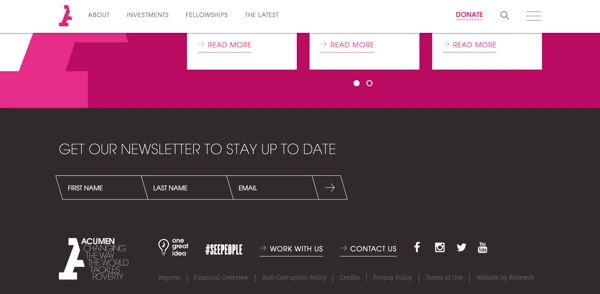
👉🏼Nonprofit marketing tip: Automate as much as possible. Email marketing automation (like HubSpot) saves precious time and energy for your team and can be the key to growing your email list, donations, and memberships. You can also automate an email sequence triggered by website visitor behavior indicating a high level of interest, such as downloading educational content.
Click here to download our free beginner's guide to email marketing.
Nonprofit Event Marketing
Event marketing is one of the most effective (and enjoyable) ways to grow awareness of your organization, connect with your community, raise funds, and garner support for your cause.
PAWS, which stands for Pets Are Worth Saving, is another local animal rescue I'm a fan of. They hold a PAWS 5K race every summer to raise awareness and funding for the organization.
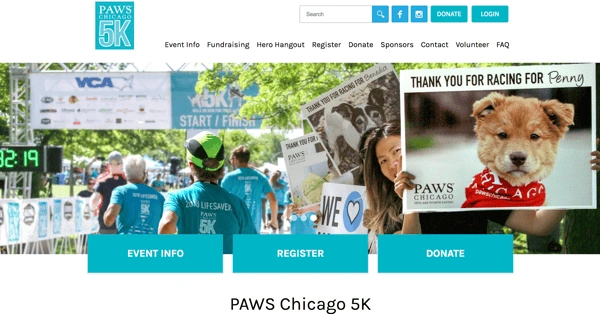
This type of event is impactful for multiple reasons:
- It inspires competition and physical activity. Runners raise money for the organization and participate in the run.
- It brings people in the community together to celebrate the organization and bring awareness to the PAWS cause.
- It provides PAWS a channel to promote their services and adoptable pets.
- It's fun to attend and be a part of! Many people go to the event to support runners, play with dogs, and simply be a part of the fun, all while supporting and sharing PAWS.
From fundraisers to auctions to competitions, you can organize many different kinds of events to market your nonprofit organization.
Nonprofit Video Marketing
Whether they're consuming content for work, school, or fun, people prefer video content. As a nonprofit organization, video marketing is a surefire way to garner interest and support from all of your audiences.
Here are a few reasons video can help you market your nonprofit:
- Video is visual. We process visual content 60,000 times faster than written content. We also remember more content longer.
- Video is personal. It inspires empathy and emotions, which can't be said about other types of marketing.
- Video is educational. Many organizations need to educate their communities on their causes in order to garner attention and funding. Video can help you do that.
- Video is shareable. Consumers love sharing videos, especially those that inspire and resonate with them.
- Video is interesting. 60% of people report that video is a media they consume thoroughly. Keep your visitors, followers, and supporters engaged and interested using video.
→ Access Now: Video Marketing Starter Pack [Free Kit]
The Girl Effect, a nonprofit that works to empower girls worldwide, is a great example of video marketing. The organization's homepage is a video that captures visitors' attention right away. Moreover, when you click "See more," the site opens an informative video telling you all about The Girl Effect.

Nonprofit Social Media Marketing
Social media is a highly popular marketing strategy among nonprofits. Not only is it free, but it also provides an avenue for organizations to show their brand personalities and engage with their followers and supporters.
Here are some ways to use social media for your nonprofit marketing, as inspired by a HubSpot study of 9,000 nonprofits:
- Share news about your organization and cause
- Boost brand awareness and recognition
- Fundraise
- Recruit volunteers and employees
- Recognize donors, employees, and volunteers
Don't forget to use the key messaging you crafted in your nonprofit marketing plan to keep your social media posts consistent and targeted. Also, make the most of each platform to promote your organization, such as the Donate button on Facebook.
HubSpot customer, FIRST, which stands for For Inspiration and Recognition of Science and Technology, is a nonprofit organization that works to advance STEM (science, technology, engineering, and math) education among children.
FIRST makes use of social media in many different ways, such as using Facebook to post videos, news, fundraisers, and reviews, as well as making use of the Donate button. The organization has amassed almost 100,000 followers.
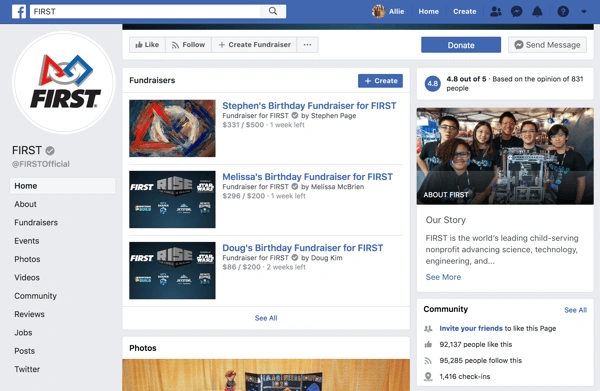
👉🏼Nonprofit marketing tip: Curate content from volunteers, customers, supporters, event attendees, and donors. Implementing a user-generated content (UGC) campaign lessens your workload and acts as strong social proof.
To enact your UGC campaign, put out a call for constituent stories, images, and videos. Create a hashtag that people can use to alert you of new UGC.
Also, let curation tools work for you. Use Google Alerts and social monitoring tools to alert you when your organization, hashtags, or relevant topics or keywords are mentioned. This provides opportunities to source UGC, get inspiration for new topic ideas, and participate in relevant conversations.
Nonprofit Website
Every nonprofit organization should have a website, which can be created on a CMS such as Content Hub or WordPress. A website serves as a digital home base for your organization and includes critical information — what you stand for and how visitors can participate and help.
Your website also houses important assets like your blog, social media streams, event information, videos, and the rest of your marketing strategies. Lastly, your website serves as a way to intrigue, inspire, and engage your audiences.
Nonprofit organization (and HubSpot customer), American Nursing Association (ANA), is an example of an organization with an outstanding nonprofit website. The site clarifies the ANA mission, shares news and educational content, and informs visitors how to get involved through memberships, events, certifications, or donations.
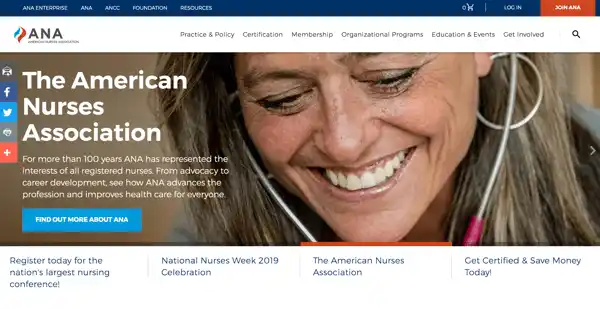
Nonprofit Public Speaking
People buy into other people, not products. The same can be said about nonprofit organizations. If consumers believe in the people behind your organization, they're likely to buy into your cause and donate money or time.
Public speaking is one of the best ways for consumers to get to know your leadership team, not to mention spread the word about your cause and organization. Whether you speak at a local event of 100 people or a multi-day conference with thousands, the impact is the same: telling a powerful story to real people who may not yet know about your cause.
Scott Harrison, the founder of charity: water, spoke at INBOUND. While he shared information about the conception and organization of the nonprofit, he mostly talked about the people that his organization helps and how the audience can support the mission. Harrison not only moved an audience of thousands but also effectively marketed the charity: water purpose and brand.
Nonprofit Content Marketing
Content marketing and blogging are valuable marketing assets for any nonprofit organization. Here's why:
- Content educates your audiences about your mission, cause, and industry news and trends.
- Content (and SEO) bring in new visitors, subscribers, donors, and leads.
- Content is shareable and serves as free PR among your audiences.
- Content can be repurposed and made into different types of media, saving your marketing team precious time and energy.
Creating a nonprofit marketing blog isn't always easy. Teams are short-staffed, budgets are low, and time is precious. Thankfully, there are many ways around those blogging challenges, such as sourcing story ideas from volunteers, donors, and customers and implementing an editorial calendar so you can plan ahead.
One of my very favorite nonprofit organizations is called Blurt Foundation. This UK-based organization exists to increase awareness and understanding of depression and support those who struggle with it.
There are many misconceptions and misunderstandings about depression, so Blurt Foundation uses its blog content and other content resources to educate constituents and supporters.
It also incorporates these content assets into its emails, social media posts, and online store.
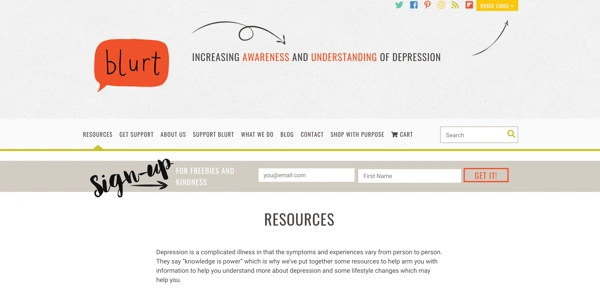
👉🏼Nonprofit marketing tip: Save time and resources by repurposing your content. It’s an appreciating asset you can reuse and re-promote repeatedly. Repurposing content to create new marketing assets costs far less than creating entirely new content.
Outline all the ways you could repurpose the content you produce. For example, you could create the following list for your blog content:
- Short versions of posts for use in emails or newsletters with links back to full posts.
- Groups of related posts for report
- Two to three visuals images to share on social
- Infographics with post information
- Reaction pieces to the original post
Since you're not going to promote and distribute each piece of repurposed content immediately, your content pipeline is never empty.
Check out HubSpot's free nonprofit content today.
Nonprofit Digital Marketing
You can market your nonprofit using search engine optimization (SEO) and search engine marketing (SEM). SEO is the process of optimizing your nonprofit’s content to get traffic from organic search results.
On the other hand, SEM is the process of getting traffic and visibility from both organic and paid search.
Nonprofits can use keywords in their blogs, videos, podcasts, and other digital content to improve their search engine rankings.
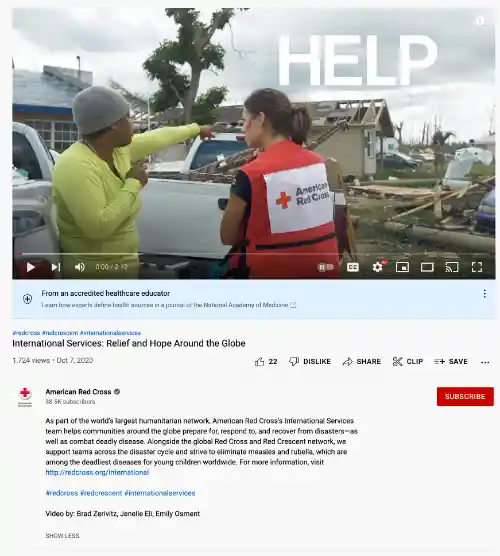
The American Red Cross uses many forms of digital content in its marketing, including YouTube videos.
The organization uses keywords to help search engines rank the content for SEO and help their audience find their content through organic search.
For example, the above video uses the keywords “red cross” and “disaster” in its description to rank in search engine results.
Nonprofits can leverage search engine marketing to increase their contributions through search engine ads.
Google’s Ad Grants program gives nonprofits grants of up to $10,000 per month to advertise their organizations. Many nonprofits — including DonorsChoose.org, We Care Animal Rescue, and SOS Children’s Villages — use Google Ad Grants to attract donations, drive awareness, and recruit volunteers.
Strengthen Your Marketing, Promote Your Cause
Raise your hand if your organization has to constantly do more with less. 👋🏼
If that sounds like your organization, I suggest you use this guide to build a nonprofit marketing plan ASAP. Your organization might not operate for profit, but it can still gain value from the traffic, funds, and awareness that systematic marketing brings in.
These activities and strategies will help promote your organization and take a valuable load off your team’s and volunteers' backs, freeing them to dedicate more time to your cause and constituents.
Editor's note: This post was originally published in June 2019 and has been updated for comprehensiveness.
Nonprofit Marketing

.png)
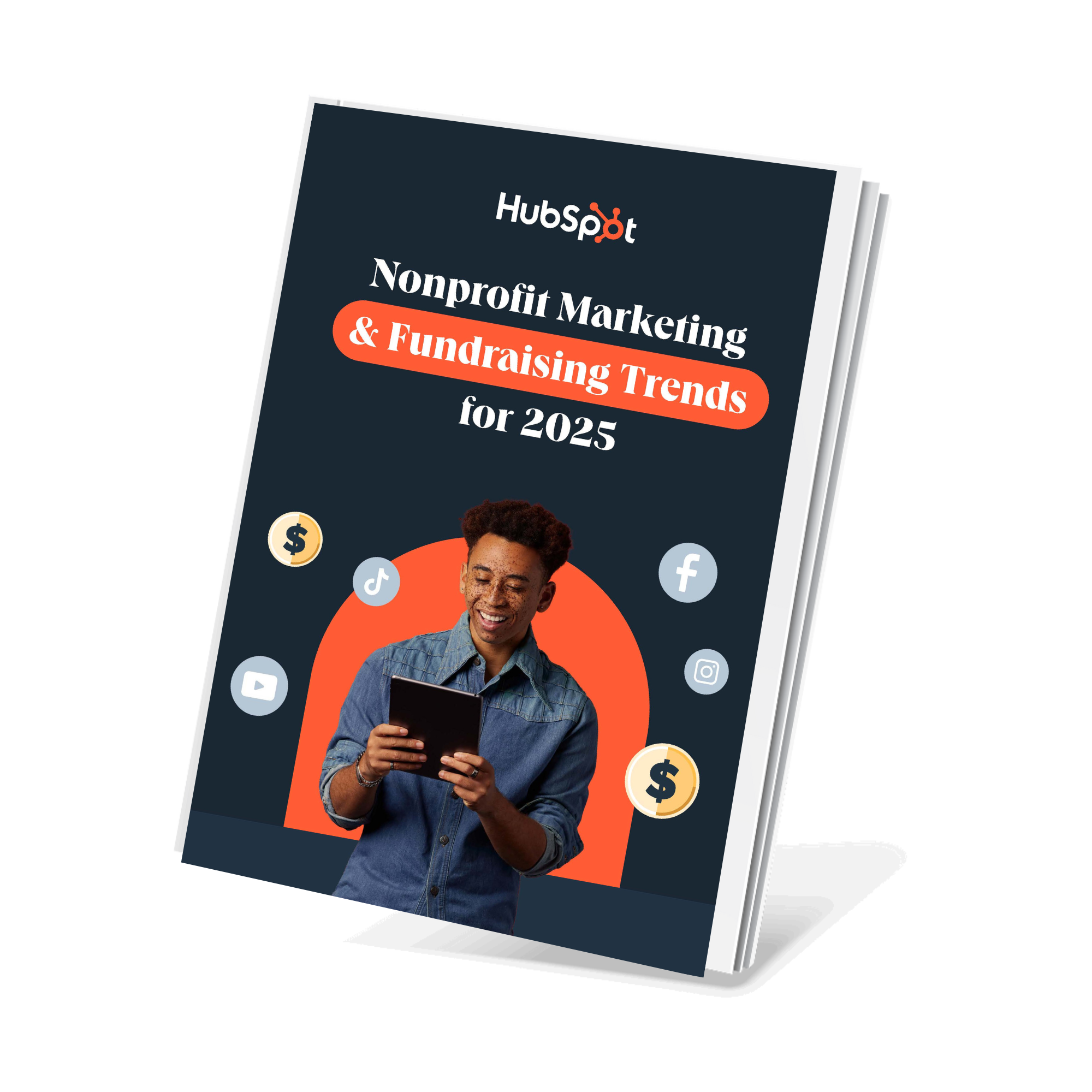



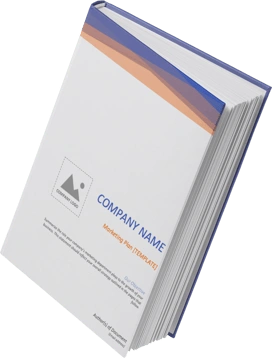



![I Mastered How to How to Create Meaningful Nonprofit Emails, Here Are All My Secrets [+ Nonprofit Newsletter Examples]](https://53.fs1.hubspotusercontent-na1.net/hubfs/53/nonprofit.jpg)





